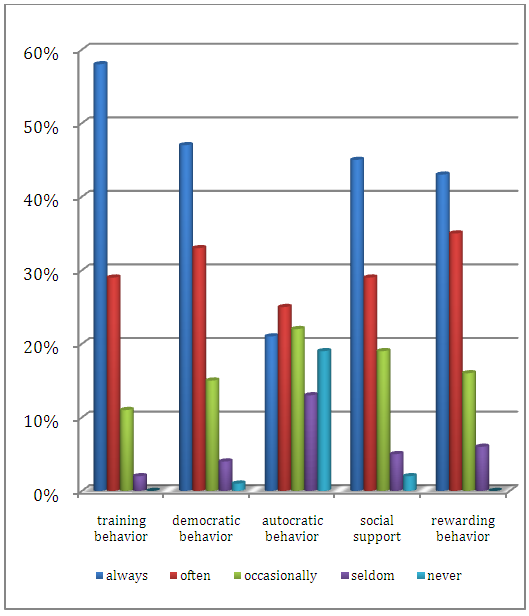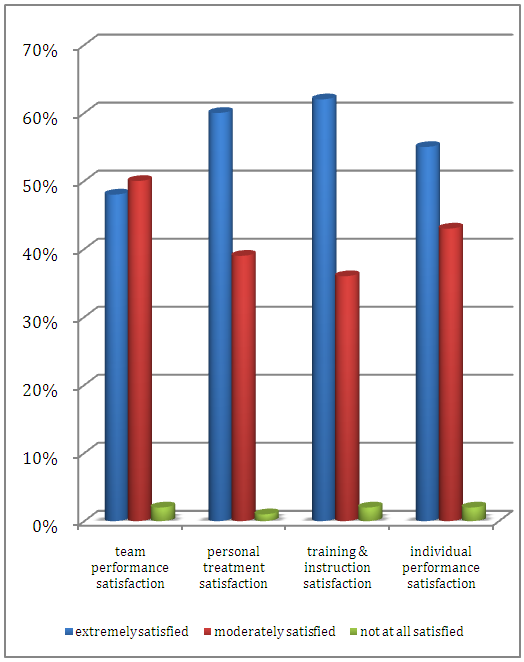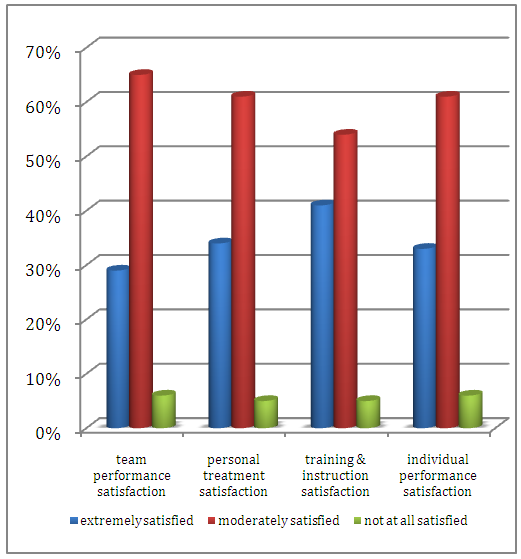-
Paper Information
- Paper Submission
-
Journal Information
- About This Journal
- Editorial Board
- Current Issue
- Archive
- Author Guidelines
- Contact Us
International Journal of Sports Science
p-ISSN: 2169-8759 e-ISSN: 2169-8791
2017; 7(5): 196-202
doi:10.5923/j.sports.20170705.04

The Relationship between Perceived Coach Leadership Behaviors and Athletes Satisfaction
Rodolfo A. Ignacio III1, Rona C. Montecalbo-Ignacio2, Rowena C. Cardenas2
1Department of Physical Education, College of Arts and Sciences, Laguna State Polytechnic University, Los Baños Campus, Philippines
2Department of Human Kinetics, College of Arts and Sciences, University of the Philippines Los Baños, Philippines
Correspondence to: Rona C. Montecalbo-Ignacio, Department of Human Kinetics, College of Arts and Sciences, University of the Philippines Los Baños, Philippines.
| Email: |  |
Copyright © 2017 Scientific & Academic Publishing. All Rights Reserved.
This work is licensed under the Creative Commons Attribution International License (CC BY).
http://creativecommons.org/licenses/by/4.0/

Athletes’ satisfaction on his/her specific sports is an essential factor to achieve optimum athletic performances. Satisfaction of athletes is a feeling of fulfillment/contentment derived from perceived and experienced leadership and behaviors exhibited by coaches. The purpose of this study was to determine the correlation between perceived coach leadership behaviors and satisfaction of collegiate athletes in the Philippines. Results revealed that there was a relationship between coach leadership behaviors and athletes’ level of satisfaction. Coaches who exhibited more on training and instruction, giving recognition, rewards, and positive feedback, and socially supportive behaviors produced more satisfied athletes. Moreover, rewarding behavior of coaches was the best predictor of team performance satisfaction and coaches’ leadership behaviors that focused on the training process to improve athletic performances was the best predictor of personal treatment satisfaction, training and instruction satisfaction, and individual treatment satisfaction of the athletes. There was no significant relationship found between autocratic leadership style of coaches and athletes’ level of satisfaction.
Keywords: Leadership behaviors, Athletes’ satisfaction, Coach, Collegiate athletes, Philippines
Cite this paper: Rodolfo A. Ignacio III, Rona C. Montecalbo-Ignacio, Rowena C. Cardenas, The Relationship between Perceived Coach Leadership Behaviors and Athletes Satisfaction, International Journal of Sports Science, Vol. 7 No. 5, 2017, pp. 196-202. doi: 10.5923/j.sports.20170705.04.
Article Outline
1. Introduction
- Coaching sports is a tough responsibility. A coach is not just focused in developing and nurturing talent/skills and optimum physical performances of the athletes alone but also considers his own personal characteristics that could have positively or negatively effect on his/her behavior towards coaching. Athletes’ perceptions about their coach’s leadership behaviors play a vital role that influence feelings of satisfaction or the opposite which is feeling of burnout on their sports involvement. Chelladurai [3, 4] stated that the perceived and preferred leadership behaviors of coaches would impact on the athletes’ level of satisfaction and that perceived leadership behaviors was also an important predictor on the athlete’s success in their sports career and satisfaction in their sports life [2].Satisfaction is an essential portion of enjoyment in sports participation [2] without satisfaction athletes would have an urge to find other sources of potential enjoyment [13]. Athlete’s satisfaction on their specific sports involvement was an outcome resulting from a complex evaluation regarding quality management, leadership and behaviors of coaches perceived and experienced by athletes [19]. Numerous investigations found evidences that coaches’ leadership behaviors towards training and instruction, positive feedback, and social support significantly correlated with athletes’ satisfaction [17, 12]. Moreover, athlete’s perception of their coach behaviors in regards of athlete-participated decision-making and giving recognition and awards produced more satisfied athletes [21]. Types of sports participation and gender differences were also examined in the previous studies [6, 21]. Results revealed that male athletes participated in team sports displayed greater perceptions in terms of training and instruction, democratic behavior, social support, and positive feedback, and lower perceptions in the autocratic behavior. Chelladurai [6] stated that the greater the perceptions of social support, training, democratic, and rewarding behaviors, and the lower the perceptions of autocratic behavior the greater the athletes’ satisfaction.The present study examined the relationship between perceived coach leadership behaviors on the satisfaction of athletes in collegiate level, since college athletes exhibited high level of socially supportive behaviors from their coaches [11, 7] due to excessive demands of training, competitions, and academics schedules [15, 16]. Participants were categorized as those who participated in individual and team sports event in the Philippines. Results of this study will serve as cognizance for coaches and trainers of various sports event to give/stretch attention on their behaviors towards coaching since athletes were highly dependent on them. Any destructive behaviors and actions of coaches and trainers during training and competitions would have a massive impact on the over all performances and psychological well being of athletes. Let the voice of the athletes be heard to develop an effective coach-athletes relationship wherein this will serve as a key to a successful sportsmanship.
2. Materials and Method
- A total of 111 college athletes (43 males and 68 females), aged 16-24 participated in this study. They represent five (5) different individual sports event and four (4) different team sports events (Table 1). The selected sports events were the most number of participants during State Colleges and Universities Athletic Association (SCUAA), Southern Tagalog Regional Association of State Universities and Colleges (STRASUC), and National Collegiate Athletic Association (NCAA) competitions. Participants were selected college athletes from Batangas State University (BSU), University of the Cordilleras (UC), Philippine Women’s University – Calamba (PWU), Polytechnic University of the Philippines (PUP), and University of the Philippines Los Baños (UPLB), Philippines.
|
2.1. Coach Leadership Behavior
- Perceived behavior of coaches was assessed using Leadership Behavior Scale (athlete’s perception of coach’s behavior) [5]. The instrument consisted of 40 questions that described leadership behavior that a coach may exhibit. Responses were rated on 5-point Likert scale (5= always to 1= never). This questionnaire measured five dimensions of coaching behaviors namely: (1) training behavior, focused on the training process to improve athletic performances, (2) democratic behavior, related to decision making wherein coaches allowed their athletes to be involved in making decision on important matters, (3) autocratic behavior, related to decision making wherein coaches doesn’t allow their athletes to be involved in making decision on important matters, (4) social support, refers to the behavior of coach directly towards the athletes’ personal needs, and (5) rewarding behavior, refers to giving recognition and positive feedback on the athletes effort and performances.
2.2. Athlete’s Satisfaction
- Athlete’s satisfaction was assessed using Athlete Satisfaction Questionnaire [17], it was consisted of 14 questions indicating athlete’s satisfaction in terms of the following: (1) training and instruction satisfaction, (2) personal treatment satisfaction, (3) team performance satisfaction, and (4) individual performance satisfaction. Responses were rated on 7-point Likert scale ranging from 1 (not satisfied at all) to 7 (extremely satisfied).
3. Results and Discussion
3.1. Perceived Coach Leadership Behaviors in Terms of Gender
- Male and female participants were asked on their perception concerning their coach leadership behaviors exhibited in giving training and instruction, decision-making, social support, and recognition/awards/positive feedback. Figures 1 and 2 showed that among the five dimensions of leadership styles both male (47%) and female (42%) athlete respondents exhibited higher perception on the training behavior of their coaches, a behavior that focused on the training process to improve athletic performances. In terms of democratic behavior or a behavior related to decision-making wherein coaches allowed their athletes to be involved in making decision on important matters, male athletes (43%) while (34%) from female athletes stated that their coach “always” exhibited this kind of behaviors. Findings of this study contradicted with the study of Chelladurai and colleague [7] that female athletes exhibited more on democratic coaching style than male athletes. In terms of autocratic behavior or a behavior related to decision making wherein coaches doesn’t allow their athletes to be involved in making decision on important matters, male got (26%) and only (17%) from female athletes revealed that their coach “always” exhibited this behavior. This result supported with Chelladurai and colleagues [7] and Terry [21] that male athletes perceived their coach leadership behaviors exhibited more on autocratic behavior than female counterpart. In terms of social support or refers to the behavior of coach directly towards the athletes’ personal needs, female athletes got higher perception of (41%) compared to male athletes (34%). Findings of this study opposed with Chelladurai and colleagues [7] that a male athlete sees their coach leadership behaviors exhibited more on social support. However, in terms of rewarding behavior or in giving recognition/awards and positive feedback, majority of the male athletes (43%) stated that their coach were “frequently” exhibited this kind of behavior, while majority of the female athletes (35%) stated that their coach “always” exhibited this kind of behavior. Results of the study supported Gardner and colleagues [12] that female athletes displayed higher perception on training behavior, democratic behavior, and rewarding behavior than male athletes. In addition, findings of this study revealed that male athletes displayed high perception in training behavior, democratic behavior, rewarding behavior, social support, and low perception in autocratic behavior, while female athletes exhibit greater perception in training behavior, social support, rewarding behavior, democratic behavior, and lower perception in autocratic behavior.
 | Figure 1. Male athletes’ perception of their coach leadership behavior |
 | Figure 2. Female athletes’ perception of their coach leadership behavior |
3.2. Perceived Coach Leadership Behaviors in Terms of Type of Sports
- Individual sports and team sports athlete participants were asked on their perception regarding their coach leadership behaviors exhibited in giving training and instruction, decision-making, social support, and recognition/awards/positive feedback. Figures 3 and 4 shows that in terms of training behavior, majority of the individual sports athletes (58%) stated that their coach “always” exhibited behaviors that focused on the training process to improve their athletic performances while (38%) from team sports athletes stated that their coach were “occasionally” exhibited this kind of behaviors. In terms of democratic behavior or a behavior related to decision-making wherein coaches allowed their athletes to be involved in making decision on important matters, individual sports athletes (47%) stated that their coach “always” exhibited this kind of behavior while team sports athletes (33%) exhibited “occasionally”. This result opposed with the study of Diatelivi [10], Terry [21], Chelladurai and Arnott [8], Chelladurai and colleagues [7] that team sports athletes perceived and preferred more on democratic coaching style than individual sports athletes. In terms of autocratic behavior or a behavior related to decision making wherein coaches doesn’t allow their athletes to be involved in making decision on important matters, individual sports athletes (21%) and (18%) from team sports athletes shows that their coach “always” exhibited this kind of behavior. Result of this study validated the study of Chelladurai and Arnott [8], Diatelivi [10], Terry [21] that individual sports athletes perceived and preferred more on autocratic leadership behavior of coaches. In terms of social support or refers to the behavior of coach directly towards the athletes’ personal needs, both individual sports athletes (45%) and team sports athletes (29%) displayed higher level of perception. This result confirmed with Erle [11], and Chelladurai and Carron [7] that college athletes participated in individual and team sports event perceived high level of socially supportive behavior exhibited by their coaches. In terms of rewarding behavior or in giving recognition/awards and positive feedback, individual sports athletes displayed high level of perception (43%) stated that their coach “always” exhibited this kind of behavior, while team sports athletes (36%) stated that their coach “often” exhibit this kind of leadership style. However, a deeper analysis of data in Figure 4 revealed that among the five dimensions of coach leadership behaviors, rewarding behavior (34%) got the highest level of perception from team sports athletes. Findings of this study confirmed previous study that rewarding behavior exhibited by coaches was the best predictor of team sports athletes’ satisfaction [9, 18, 22].
 | Figure 3. Individual Sports athletes’ perception of their coach leadership behavior |
 | Figure 4. Team Sports athletes’ perception of their coach leadership behavior |
3.3. Athletes Satisfaction in Terms of Gender and Type of Sports
- Male and female athletes respondents participated in individual and team sports event were asked to rate their level of satisfaction in terms of team performance satisfaction, personal treatment satisfaction, training and instruction satisfaction, and individual performance satisfaction. Figures 5 and 6 show that in terms of team performance satisfaction or athlete’s satisfaction with his/her team level of performance (TPS), both male (50%) and female (53%) athletes were “moderately satisfied”. Result of this study opposed with the findings of Abu Samah and colleagues [1, 11] that majority of athlete-respondents have high level of satisfaction in terms of team performance satisfaction. However, both male and female athletes were “extremely satisfied” in terms of personal treatment satisfaction or athletes satisfaction with those coaching behaviors that directly affect the individual yet indirectly affect team development (PTS), training and instruction satisfaction or athletes satisfaction with the training and instruction administered by the coach (TIS), and individual performance satisfaction or athletes satisfaction with his/her own performance (IPS). Figure 7 shows that individual sports athletes were “extremely satisfied” while figure 8 revealed that team sports athletes were “moderately satisfied” on the four dimensions of satisfaction. A deeper analysis of data in Figures 5, 6, 7, & 8 revealed that there were some of the male and female athletes participated in individual and team sports event who were “not at all satisfied” on the four dimensions of satisfaction.
 | Figure 5. Male athletes’ level of Satisfaction |
 | Figure 6. Female athletes’ level of Satisfaction |
 | Figure 7. Individual Sports athletes’ level of Satisfaction |
 | Figure 8. Team Sports athletes’ level of Satisfaction |
3.4. Relationship between Perceived Coach Leadership Behaviors and Athletes Satisfaction
- Table 2 shows the significant relationship between perceived coach leadership behaviors and satisfaction of athletes. In terms of team performance satisfaction, there were highly significant correlations with perceived coach leadership behaviors of training behavior (r=0.589), democratic behavior (r=0.526), social support (r=0.542), and rewarding behavior (r=0.608). Result of this study revealed that among the leadership behaviors of coaches, rewarding behavior or giving recognition/awards and positive feedback (r=0.608) was the extreme indicator of team performance satisfaction, supported with the study of Coffman [9], Riemer et.,al [18], and Weiss et.,al [22] that rewarding behavior exhibited by coaches were the best predictor of team satisfaction. In terms of personal treatment satisfaction, training and instruction satisfaction, and individual performance satisfaction, there were highly and significantly correlated with training behavior, democratic behavior, social support, and rewarding behavior. Result of this study shows that among the other leadership behaviors of coaches, training behavior or a behavior of coaches that focused on the training process to improve athletic performances was the best predictor of athletes’ personal treatment satisfaction, training and instruction satisfaction, and individual performance satisfaction. Confirmed with the studies of Schleisman [19], Horne and Colleague [13] that coach leadership behaviors towards training and instruction and positive feedback correlated with athletes’ satisfaction. However, there were no significant relationship found between athletes’ satisfaction and autocratic behavior of coaches. Results of this study indicated that athletes with high perception on their coach leadership behaviors regarding training, giving recognition/awards/positive feedback, social support, democratic behavior, and low perception on autocratic behavior produced more satisfied athletes. Confirmed with the study of Chelladurai et.,al [7] that the higher the perceived scores except in autocratic behavior the higher the satisfaction in leadership, and coaching behaviors displayed more on training and instruction, positive feedback and social support most highly correlated with athletes satisfaction [19, 13].
|
4. Conclusions and Recommendations
- Results revealed that there was indeed a correlation between coach leadership behaviors and athletes’ level of satisfaction. Coaches who exhibited more on training and instruction, giving recognition, rewards, and positive feedback, and socially supportive behaviors produced more satisfied athletes.Therefore, based on the results, researchers suggested that coaches of male and female athletes participated in individual sports and team sports event should exhibit more on training behavior and positive feedback.Sports directors/administrators should include coach leadership style and behaviors on the criteria in selecting/hiring coaching job. Suitable coach-athletes relationship is one of the factors that contribute successful sports career of the athletes and coaches as well.Further investigations on related topics will provide immediate feedback to coaches seeking information about athletes' perceptions of their coaching performance. Accordingly, the data gathered can enhance a coach’s ability to interact more effectively with athletes.
ACKNOWLEDGEMENTS
- The authors would like to acknowledge the student-athletes from different Universities in the Philippines who participated and spent their time completing the questionnaires and Dr. Marcial M. Bandoy for the enhancement of the statistical analysis of this study.
 Abstract
Abstract Reference
Reference Full-Text PDF
Full-Text PDF Full-text HTML
Full-text HTML
